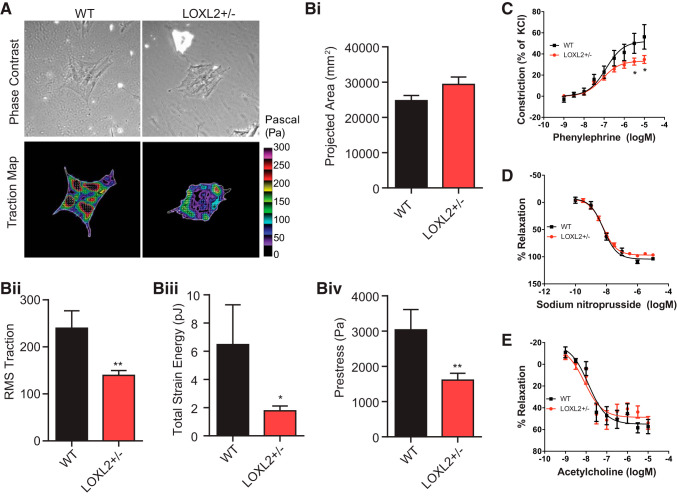Fig. 7.
Lysyl oxidase-like 2 (LOXL2) depletion decreases vascular smooth muscle cell (VSMC) contractility. A: representative phase contrast and traction map images of VSMCs from old (15 mo old) wild-type (WT) and LOXL2+/− cells as measured by Fourier transform traction microscopy. The white lines show the cell boundary, and the colors show the magnitude of the traction force in Pascals indexed to the color bar at the right. Bi–Biv: computed projected area (Bi), traction stress (Bii), and derived strain energy (Biii), and prestress (Biv) of isolated VSMCs. For these studies, cells were plated onto an inert elastic gel (8 kPa) coated with type I collagen (WT, n = 18; LOXL2+/−, n = 19 individual cell measurements). For data that were not normally distributed [root mean squares (RMS) traction, total strain energy, and prestress], statistical analyses were performed on transformed data (*P < 0.05, **P < 0.01 by Student’s t-test). C: constriction response of LOXL2+/− and WT mouse aortic rings to increasing concentrations of phenylephrine (n = 8 per group; *P < 0.05 vs. WT at same phenylephrine concentration by Kruskal-Wallis test with Dunn’s post hoc correction). D and E: endothelial-independent relaxation of vessels pre-constricted with phenylephrine with increasing concentrations of sodium nitroprusside (n = 8; D) and endothelial-dependent relaxation of vessels preconstricted with phenylephrine with increasing concentrations of acetylcholine (n = 8; E) in LOXL2+/− and WT mouse aortic rings.

